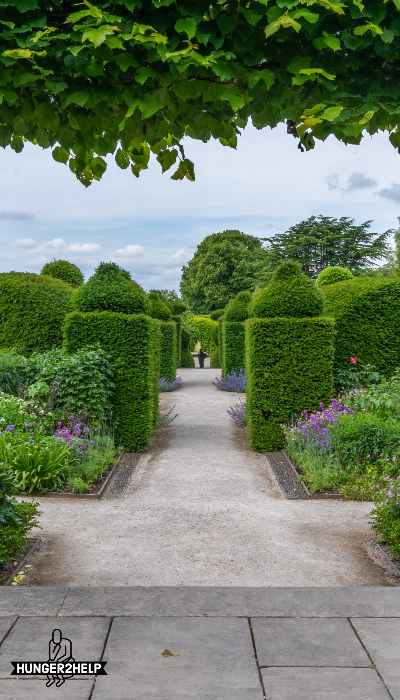Starting your own medicinal garden can seem like an overwhelming endeavor to the uninitiated, but it’s actually quite simple and rewarding once you get the hang of it. Just follow these seven tips and your medicinal garden will soon be flourishing in no time.

What Are Medicinal Gardens?
A medicinal garden is an outdoor space where herbs, fruits, and vegetables are grown for their healing properties. These gardens can be found in hospitals, clinics, homes, and even workplaces. They offer a place of respite and relaxation, as well as a source of natural remedies.
Here are 7 ideas for creating your own medicinal garden:
1. Start small. You don’t need a large space to create a medicinal garden. A few pots on your balcony or windowsill will do the trick.
2. Consider your climate. Choose plants that will thrive in your local climate.
3. Think about what you want to grow. Do you want to grow herbs for cooking? Plants for making teas? Fruits and vegetables for juicing? Herbs to use in crafts or decorating? Once you have decided what you want to grow, it’s time to research which types of plants would work best for your needs.
4. Learn about organic gardening techniques. Organic gardening refers to growing without using synthetic pesticides, herbicides, fungicides, or fertilizers. Researching organic gardening techniques before planting anything into the ground will help keep pests away and give your plants the healthiest start possible!
5. Plant more than one type of plant together. Doing so ensures pollination and gives you the most variety when harvesting leaves, fruit, or flowers.
6. Don’t forget to water! And mulch around your plants for better drainage and fewer weeds.
7. Get creative with containers. Flowers can be grown in hanging baskets or old wicker baskets; herbs can be grown in window boxes; veggies can be grown in clay pots; fruit trees should go outside but potted citrus trees could add some color indoors during winter months; just make sure not to overwater any potted plants because they won’t get enough air circulation as they would outdoors.
Start Small
1. Start small and simple by planting just a few medicinal herbs in pots on your porch or patio. Rosemary, basil, and mint are all good choices.
2. Plan ahead by doing some research on which plants will do well in your area and what kind of care they will need.
3. Don’t forget to consider the mature size of the plants when you are choosing what to grow. You don’t want your garden to get too overgrown!
4. Pick a sunny spot for your garden, as most medicinal herbs need at least six hours of sunlight each day.
5. Make sure you have a water source nearby so you can easily water your plants.
6. Enjoy watching them grow into a productive and colorful patch of green!
7. When harvesting your leaves, make sure to only take a little bit from each plant- these herbs will thrive with this gentle touch.
8. And finally, be mindful that not every herb is appropriate for internal consumption- always read up on the individual herb before trying it out yourself!
Focus on One Plant Each Season

Creating a medicinal garden doesn’t have to be complicated or time-consuming. In fact, you can start small by focusing on one plant each season. Here are seven ideas to get you started.
1. Plant mint in the spring – Mint is easy to grow and has many uses including helping with digestion and as an insect repellent.
2. Plant basil in the summer – Basil is also easy to grow and is best used fresh because it loses its flavor when dried.
3. Plant thyme in the fall – Thyme is great in chicken soup, meat dishes, and any savory dish that needs a little extra flavor.
4. Plant garlic in the winter – Garlic has many medicinal qualities including being antibacterial and antifungal. Use it liberally during cold months!
5. Plant ginger root in late winter/early spring – Ginger helps with nausea, motion sickness, digestive issues, and joint pain! It’s also good for your immune system.
6. Plant cilantro in early fall – Cilantro is anti-inflammatory and good for your heart health. It tastes good too! So whether you’re looking to prevent or treat illness, these plants are sure to help you stay healthy this year. As always, consult your doctor before starting any new diet or exercise routine.
Use Plant Families in Your Garden
If you’re interested in growing your own medicinal plants, there are a few things to keep in mind. First, consider which plant families you’d like to include in your garden. For example, the Asteraceae family includes daisies, sunflowers, and chamomile; the Lamiaceae family includes mint, basil, and rosemary; and the Solanaceae family includes tomatoes, peppers, and potatoes.
Each of these families has many members that can be used medicinally. Once you know what plant families interest you, research the different herbs within each family to see which ones would work best for your needs. Remember to choose varieties that will grow well in your climate. Once you’ve chosen some, go ahead and find out how much space they’ll need and how much sunlight they’ll need as well. You’ll also want to take into account soil requirements (some plants do better with richer soil).
Choose Disease Resistant Plants

When it comes to growing medicinal plants, one of the most important things to consider is disease resistance. No one wants to deal with sick plants, so choosing varieties that are known to be resistant to common diseases is a great place to start. Here are seven ideas for disease-resistant medicinal plants that are perfect for beginners.
1. Basil – Basil is a very easy plant to grow and maintain which makes it ideal for beginners. It’s also incredibly versatile, making it an excellent choice when you’re looking for recipes or herb combinations. It’s also naturally pest-resistant and cold-hardy making it perfect as an indoor plant or if you live in an area where winters get cold.
2. Mint – Mint has long been used in tea blends, but you can also use this popular herb in cooking or even as an edible garnish on salads or other dishes. Like basil, mint is both cold-hardy and pest-resistant which makes this another good choice if you live in a colder climate. In addition to being tasty and useful, mint helps repel mosquitoes!
3. Catnip – Catnip isn’t just for cats! Those who like catnip tea say it promotes sleep and eases anxiety. Cats love catnip too, which is why many gardeners will keep some around just for them.
4. Lemon Balm – Lemon balm is often added to tea blends or herbal preparations because it contains citronella oil. Citronella oil is well-known for its ability to repel mosquitoes and make your yard more enjoyable during summer months when mosquitos might otherwise be out in droves.
5. Lavender – Lavender has a delightful fragrance that many people find soothing, including bees who love its flowers because they produce such delicious honey from them! One of the reasons lavender is so popular among beekeepers is that it produces prolifically while still being fairly hardy.
6. Thyme – Thyme may not look like much at first glance, but don’t let this small plant fool you! It actually produces quite a lot of flavor and aroma once harvested. Thyme can be used fresh or dried in soups, stews, roasts, sautés, and sauces or sprinkled over bread before baking.
7. Oregano – Oregano is best known for giving the pizza its signature flavor (at least according to traditionalists), but oregano also has antibiotic properties which make it perfect for any dish that requires lots of chopping as well as a number of other health benefits.
8. Sage – Sage is one of those herbs that simply tastes better dried than fresh, which means it can add tons of flavor to all sorts of dishes without taking up precious space in your refrigerator. Like thyme, sage is also pretty hardy and low maintenance so even novice gardeners shouldn’t have trouble keeping it alive.
9. Garlic Chives – Garlic chives are relatively low maintenance despite having such a strong smell and taste! This herb doesn’t need much water or sunlight which means you can usually harvest it anytime throughout the year without worrying about killing it off.
10. Parsley – Parsley is essential for anyone who likes dipping their veggies into ranch dressing since parsley provides the bright green color needed to top off that familiar side dish.
Maximize Sunlight in Your Garden
One of the most important things to consider when creating a medicinal garden is maximizing sunlight. After all, plants need sunlight to grow! Here are a few tips to help you maximize sunlight in your garden
- Choose sunny sides of buildings or walls with sun exposure to place your plants on
- Plant perennial herbs and flowers that attract pollinators to help spread seeds around your yard.
- Utilize planters with trellises or other climbing structures for small spaces that lack space.
- Choose tall varieties of herbaceous perennials and shrubs that will shade out weeds on the ground below them and create their own canopy.
- Provide pathways and stairways for better access to your plants.
- Place more moisture-loving plants near ponds, streams, or water features to avoid dry soil and maintain wet conditions for these plants.
- Consider placing taller trees as well as shorter ones around your garden so that they can provide more shade throughout the day and during different seasons of the year.
- Avoid overplanting because they will compete with each other for nutrients and oxygen, and this can lead to lower yields.
- Keep your lawn cut short (no higher than 6 inches) so that it doesn’t compete with nearby gardens or plants – Be mindful of your watering habits.
- Do not fertilize plants too often, which may produce excess growth that could harm certain plants.
- Always remove dead leaves and branches from plants and discard them elsewhere to keep pests away.
- Always monitor the health of your plants by checking for signs of wilting, discoloration, yellowing leaves, leaf curling, and pest infestations.
- Remove invasive species early before they take over.
Go Native
If you’re new to the world of medicinal plants, one of the best places to start is with native plants. Not only are they easy to find and identify, but they also require less maintenance than non-native species. Here are seven ideas for creating a medicinal garden that’s perfect for beginners.
1. Start With Native Plants: Non-native species can be more challenging to care for, so if you’re just getting started in this world of medicinal gardening, stick with what’s easy.
2. Create An Easy Container Garden: Once you’ve chosen your location, it’s time to choose your containers! Pick ones that are simple – think terra cotta pots or plastic containers – and plant the right plant in each container according to its size requirements. A great place to start?
A container filled with catmint! Catnip is a herbaceous perennial plant (meaning it will grow back year after year) and its flowers produce nectar that bees use as food. It’s best used medicinally as an antispasmodic agent, meaning it relaxes muscles during digestion or when dealing with stress. Catnip tea is often used to reduce fevers and colds due to the mild sedative properties that help people sleep. Cats love catnip because it causes them to feel euphoric by stimulating their pheromones which makes them want to roll around on their backs! (Disclaimer: cats don’t actually need medicine!)
Harvest Often

If you want to get the most out of your medicinal garden, you need to harvest often. This means picking leaves, flowers, and fruits as they reach maturity. You can dry or freeze herbs for later use, or make tinctures and infusions right away. The key is to not let anything go to waste. It’s also important to understand what plants in your garden are beneficial before harvesting them.
Some plants should only be harvested when young because their potency decreases as they age. Others, like elderberry bushes and tomato vines, should be left alone so that more fruit will grow on the plant. Make sure to take this into account when designing your own medicinal garden! One of the best ways to do this is by sketching out a plan with pencil and paper before planting anything. In the design process, it helps to remember that taller plants like tomatoes should be placed towards the back of your garden so smaller ones don’t shade them out.
When it comes time to replant old plants, keep in mind how long each species has been alive and whether or not it was harvested well during its life span. Plant heirloom varieties of vegetables, which have existed since ancient times, rather than genetically modified varieties found at the grocery store. Heirloom varieties have genetic diversity and produce better yields than their modern counterparts. Heirlooms are often tastier too! To create an edible barrier around your vegetable patch, interplant corn with tall bean plants around the outside edge to prevent small animals from getting inside your raised beds.
Conclusion
1. Determine what plants you want to grow. Consider which plants will best suit your needs and research their individual requirements.
2. Choose a location for your garden. Make sure it gets plenty of sunlight and is easily accessible.
3. Prepare the soil. Mix in some organic matter to help the plants thrive.
4. Plant your seeds or starts. Be sure to space them out properly and water them regularly.
5. Weeds will inevitably crop up, so be prepared to pull them as needed.
6. When the time comes, harvest your crops and dry or process them according to your needs.
7. Enjoy the fruits (or herbs) of your labor.
Also, check out the latest articles “Fruit and vegetable garden” and “Flower gardens“
Hi I’m Bilal Malik, a digital marketing and blogging expert holding years of experience.










